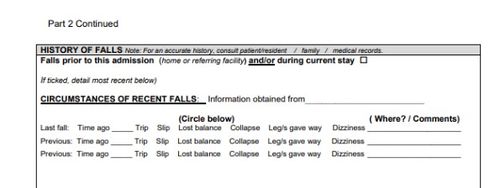The smart Trick of Dementia Fall Risk That Nobody is Talking About
The Greatest Guide To Dementia Fall Risk
Table of ContentsDementia Fall Risk Can Be Fun For EveryoneThe Dementia Fall Risk DiariesThe Greatest Guide To Dementia Fall RiskThe smart Trick of Dementia Fall Risk That Nobody is Talking About
An autumn danger analysis checks to see exactly how likely it is that you will drop. It is primarily done for older adults. The analysis generally consists of: This includes a collection of inquiries regarding your overall health and if you have actually had previous falls or problems with equilibrium, standing, and/or strolling. These tools test your toughness, balance, and gait (the means you stroll).Treatments are recommendations that might reduce your danger of dropping. STEADI consists of three steps: you for your danger of dropping for your danger variables that can be enhanced to try to protect against falls (for example, balance troubles, damaged vision) to reduce your danger of dropping by making use of effective methods (for instance, giving education and resources), you may be asked a number of concerns consisting of: Have you fallen in the past year? Are you stressed about falling?
Then you'll take a seat once again. Your provider will certainly check how much time it takes you to do this. If it takes you 12 secs or even more, it might indicate you go to greater danger for a loss. This examination checks toughness and equilibrium. You'll being in a chair with your arms went across over your chest.
Move one foot halfway forward, so the instep is touching the large toe of your other foot. Relocate one foot completely in front of the various other, so the toes are touching the heel of your other foot.
Dementia Fall Risk Things To Know Before You Get This
A lot of drops happen as an outcome of multiple contributing variables; for that reason, managing the danger of dropping starts with identifying the aspects that contribute to drop threat - Dementia Fall Risk. Some of the most relevant risk elements consist of: Background of previous fallsChronic medical conditionsAcute illnessImpaired gait and equilibrium, reduced extremity weaknessCognitive impairmentChanges in visionCertain risky drugs and polypharmacyEnvironmental variables can additionally raise the risk for falls, consisting of: Poor lightingUneven or harmed flooringWet or unsafe floorsMissing or damaged handrails and get barsDamaged or poorly equipped equipment, such as beds, mobility devices, or walkersImproper use of assistive devicesInadequate guidance of individuals residing in the NF, consisting of those that show hostile behaviorsA effective fall risk administration program needs a comprehensive scientific assessment, with input from all participants of the interdisciplinary team

The treatment strategy must additionally consist of treatments that are system-based, such as those that advertise a risk-free setting (ideal lighting, reference handrails, get bars, and so on). The performance of the interventions ought to be examined periodically, and the care plan modified as essential to show changes in the autumn danger evaluation. Implementing an autumn threat management system utilizing evidence-based ideal technique can minimize the occurrence of falls in the NF, while limiting the possibility for fall-related injuries.
Our Dementia Fall Risk Ideas
The AGS/BGS guideline recommends evaluating all grownups aged 65 years and older for loss danger annually. This testing consists of asking patients whether they have actually fallen 2 or even more times in the past year or looked for medical attention for an autumn, or, if they have not fallen, whether website link they feel unstable when strolling.
Individuals who have actually dropped once without injury must have their balance and gait evaluated; those with stride or equilibrium abnormalities need to receive added analysis. A history of 1 autumn without injury and without gait or equilibrium troubles does not call for further analysis beyond continued yearly loss risk screening. Dementia Fall Risk. A loss risk assessment is needed as component of the Welcome to Medicare examination

The Best Strategy To Use For Dementia Fall Risk
Documenting a falls background is one of the quality indicators for fall prevention and management. Psychoactive medications in particular are independent forecasters of falls.
Postural hypotension can typically be minimized by decreasing the dosage of blood pressurelowering drugs and/or stopping medications that have orthostatic hypotension as a negative effects. Usage of above-the-knee support tube and copulating the head of the bed boosted might likewise reduce postural decreases in high blood pressure. The recommended components of a fall-focused physical assessment are shown in Box 1.

A pull time better than or equal to 12 seconds suggests high loss risk. The 30-Second Chair Stand examination assesses lower extremity stamina and balance. Being incapable to stand up from a chair of knee elevation without using one's arms shows enhanced autumn threat. The 4-Stage Equilibrium test evaluates fixed equilibrium by having the person stand in 4 positions, each gradually extra tough.